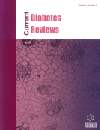-
oa Lipid Composition of Cell Membranes and Its Relevance in Type 2 Diabetes Mellitus
- Source: Current Diabetes Reviews, Volume 8, Issue 5, Sep 2012, p. 390 - 400
-
- 01 Sep 2012
- Previous Article
- Table of Contents
- Next Article
Abstract
Identifying the causative relationship between the fatty acid composition of cell membranes and type 2 diabetes mellitus fundamentally contributes to the understanding of the basic pathophysiological mechanisms of the disease. Important outcomes of the reviewed studies appear to support the hypotheses that the flexibility of a membrane determined by the ratio of (poly)unsaturated to saturated fatty acyl chains of its phospholipids influences the effectiveness of glucose transport by insulin-independent glucose transporters (GLUTs) and the insulin-dependent GLUT4, and from the prediabetic stage on a shift from unsaturated towards saturated fatty acyl chains of membrane phospholipids directly induces a decrease in glucose effectiveness and insulin sensitivity. In addition, it has become evident that a concomitant increase in stiffness of both plasma and erythrocyte membranes may decrease the microcirculatory flow, leading ultimately to tissue hypoxia, insufficient tissue nutrition, and diabetes-specific microvascular pathology. As to the etiology of type 2 diabetes mellitus, a revised hypothesis that attempts to accommodate the reviewed findings is presented.


